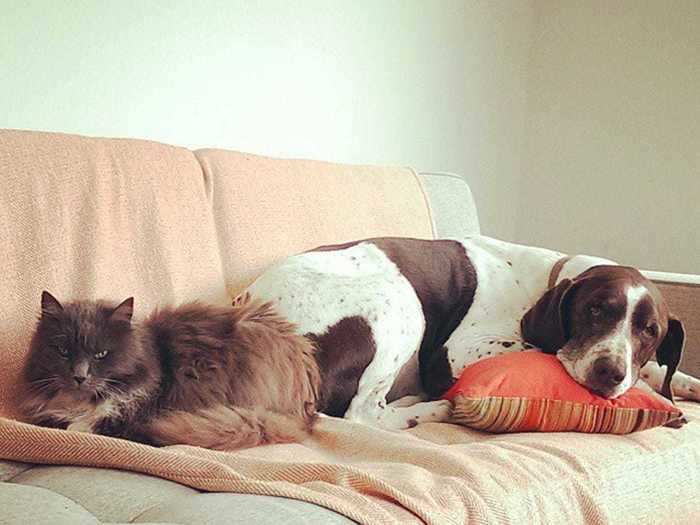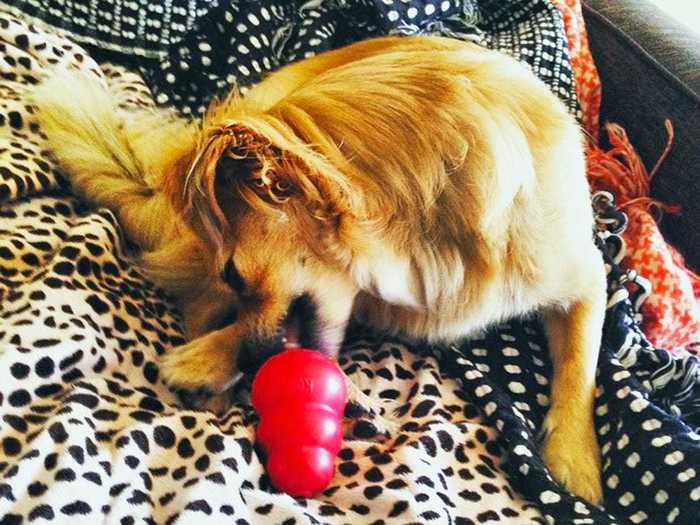GK Hart/Vikki Hart/Getty Images
When you buy through our links, we may earn money from our affiliate partners. Learn more.
- Dogs and cats are more comfortable together when they have been introduced properly.
- Introduce your cat and dog by scent and sound first and reward them for calm behavior in the presence of each other.
- When your pets are ready to share a space, be sure your cat has plenty of options for hiding and climbing.
- Here's how to introduce a dog to a cat broken down step-by-step.
As a dog trainer with nearly a decade of experience, I frequently get asked the best way to stop a new dog from harassing the family cat. It's natural for a dog to be extremely interested in a quick-moving, funny-smelling cat. It's the responsibility of the humans in the home to shape their overarousal into calmer, more respectful behavior.
Gradual introductions combined with desensitization and counterconditioning training can mean the difference between chaos and harmony in a mixed cat-and-dog household. The process should have at least four phases, beginning with the cat and dog smelling and hearing each other through closed doors. Altogether, the introduction should take at least a week. For younger and highly excitable dogs, it may take several weeks for both pets to be comfortable sharing the same space.
Read the original article on
Insider
Remove all barriers
Shoshi Parks/INSIDER
When you are confident that your dog and cat can be in the same space without stress, it's time to try out life without baby gates or leashes to manage their interactions.
- Continue to allow your dog and cat in the same space only under supervision. If you can't supervise or are away from the home, separate your dog and cat.
- Continue to reward for calm behavior from both your cat and dog and to redirect your dog into play with toys or training behaviors if they get too overly excited or fixated on the cat.
- If your dog and cat settle into a comfortable relationship after several weeks without barriers, transition to leaving them alone unsupervised.
Begin to introduce your dog and cat face-to-face
Shoshi Parks/INSIDER
When your dog begins to show less interest in your cat's den and can be easily redirected away from the baby gate, it's time to begin facilitating positive introductions face-to-face.
- For brief periods each day, put your dog on a harness and leash and remove the baby gate. Wear a bait bag full of extra-special dog treats or keep them close at hand and encourage your dog to sit or lie down next to you.
- Your cat will feel more confident if they have ways to escape the dog. Make sure there are plenty of places to hide and a cat tree or cat shelving onto which your cat can jump in order to get out of the way. Sprinkle catnip and/or treats on elevated surfaces and in hiding spots to entice them out of their den.
- When your cat begins to explore outside of their den, reward your dog for calmly watching. Offer them a stuffed Kong (or another food puzzle toy) or a long-lasting chewie to focus on instead of the cat.
- If the dog lunges toward the cat, calmly redirect them back to sitting or lying down or ask them for another behavior such as "spin" or "touch." A minute or two of play with a toy can also help to redirect the dog's energy into something more productive.
What you'll need:
Let your dog and cat see each other
Shoshi Parks/Insider
Once your pets have had a chance to become familiar with one another's scents, give them the opportunity to see each other in a safe and controlled way.
- Set up a baby gate or x-pen in the doorway of your cat's den.
- Sit with your dog as far away from the baby gate as possible and encourage them to sit or lie down next to you. Reward your dog whenever the cat is in sight, marking and rewarding with high-value treats. If they get up, rush toward the door or vocalize, encourage them to return to a relaxed position and reward them. Whole Dog Journal has more details on how to get your timing right so that it has the biggest impact.
- Ask a family member or friend to play with your dog while you sit with your cat in their den. Reward them heavily with high-value treats as they watch the dog play, helping them to form a positive association with their new canine family member.
- Repeat steps 2 and 3 frequently, keeping your training sessions to five or ten minutes at a time.
What you'll need:
Introduce cat and dog through sound and scent
Shoshi Parks/Insider
Both dogs and cats rely heavily on their sense of smell so it's a good place for introductions to begin. In the days after you first bring home your new dog, keep them not just physically separated from your cat but visually separated from them too.
- Set up a den for your cat in a room or section of the home that can be completely closed off to the dog. A bedroom is often a good option, but if your space is limited, even a bathroom will work. Make sure the room has everything your cat will need to be comfortable including a litter box, scratcher, food and water bowls, a dark place to hide, and a cozy place to sleep (a cat carrier can double as both). Use a pheromone collar or diffuser to help manage your cat's stress.
- Place a soft blanket in your cat's den and another one in a place your new dog likes to relax. Exchange them daily.
- When you are out with your dog, allow your cat to explore the whole home. Just be sure to get them back in their den before the dog can see them.
- When you are with your cat in their den, feed them extra-tasty high-value treats when the dog vocalizes or approaches the door from the outside.
What you'll need:




